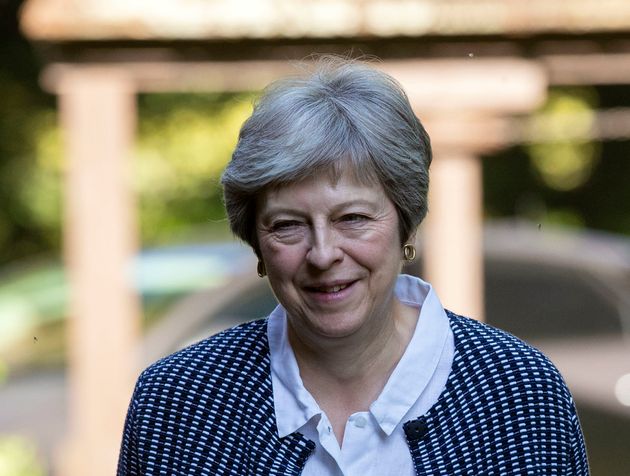
Theresa May, the UK’s embattled prime minister, is in a maze of her own making.
She has insisted that the whole of the UK must leave the European Union, even though Northern Ireland and Scotland voted to remain – thereby ruling out ‘mixed’ options in which different parts of the UK might have different relations with the EU.
Equally strongly she insists that the UK must leave the customs union of the EU, the EU’s single market with its common regulations and rules, and the jurisdiction of the Court of Justice of the European Union, which has the final say on EU law. Only this path will free the UK to make new trade agreements with other countries.
Lastly, she accepts that she must protect the Good Friday Agreement, the peace agreement and political settlement that ended most conflict in Northern Ireland in 1998, ‘in all its parts.’ As part of that pledge she has committed to avoiding any new fresh physical infrastructure and controls across the border on the island of Ireland. That border became invisible because of the UK and Ireland’s joint membership of the EU, and the demilitarization that flowed from the Good Friday Agreement.
But, May cannot have all that she says she wants. Something has to give.
Leaving the customs union means that there has to be customs barriers between the UK and the EU-27, including Ireland. Leaving the single market, policed by the Court of Justice, means that there has to be a regulatory barrier between the EU and the UK. In other words, the border must harden again.
Different ways of getting out of the maze have been suggested to Mrs May.
Smart technology, it is argued, would enable the retention of a seamless border through administering all customs and regulatory requirements somewhere else. That technology would be applied at the English channel as well as across Ireland.
And two specific ideas are currently dividing the London cabinet – a new customs partnership with the EU (in which the UK would administer two sets of customs), and ‘max-fac’ (the facilitation of recognised traders in goods).
So far, however, all such proposals are rejected by the EU, including Ireland–and sometimes derided as magical thinking. Such technologies remain unproven.
That’s why the EU proposed, and the UK accepted, in December 2017 ‘a backstop solution’ in which Northern Ireland would remain in the customs union, and within the regulatory structure of the single market, while Great Britain would leave both (and be free to make trade deals with other countries).
Problem solved? Not yet, because Mrs May, again at her own choosing, had called a general election in 2017 in which her party lost its parliamentary majority and had to make a supply and confidence arrangement with the hardline Democratic Unionist Party, the party founded by the Reverend Ian Paisley.
The DUP hates the backstop solution because it treats Northern Ireland differently from Great Britain (though on other subjects, e.g., same-sex marriage it shows much less concern). Its leaders say they would rather have a hard exit for all of the UK, and accuse the Republic of Ireland of trying to recapture Northern Ireland through European means.
Matters must shortly come to a head. Either the UK will agree to the legal entrenchment of the backstop, i.e. it will apply until there are novel and functioning technological solutions, or the EU 27 will refuse the UK a withdrawal agreement (including the draft transition agreement), thereby promising the UK a cliff-edge ‘hard exit,’ which few credible economists regard as anything other than deeply damaging.
So, Mrs May looks as if she may have to choose between facing down the DUP – and losing its support, and thereby endangering her government – or driving the UK economy off a cliff.
While contemplating this painful choice Mrs May would be well advised to look at what the Northern Irish think. A proper social scientific survey we have conducted, and our accompanying deliberative forum, provides a reliable guide.
People in Northern Ireland would much prefer to remain in the EU: 69% of them would now vote to remain if a second referendum on EU membership is held, a significant increase on the 56% who voted this way in 2016. But what happens when the Northern Irish are obliged to choose among the available exit options?
If leaving the EU is unavoidable then both Catholics (61%) and Protestants (62%) equally strongly prefer the option that dodges the need for new border checks – specifically, they want the UK as a whole to stay in the customs union and single market. That would obviate the need for any new physical infrastructure or controls – either between the North and South of the island, or along the Irish Sea. It is rare to have such a concurrent majority in Northern Ireland. its power-sharing executive and assembly are currently not functioning because of a range of disputes, including over European matters.
The next most preferred option (24%) is the ‘backstop,’ in which Northern Ireland remains in the customs union and single market while Great Britain leaves both, the option intensely disliked by the Democratic Unionist Party.
The DUP, however, can take no comfort from the fact that the least preferred option (15%) in Northern Ireland is for all of the UK to leave the Customs Union and Single Market – a so-called ‘hard Brexit.’
Our research shows significant antipathy, fear, and annoyance at the prospect of new North-South border checks. One in five Catholics would find camera-based technology at the border ‘almost impossible to accept’. Over half of Catholics, and 70% of Catholics who support Sinn Féin would find customs checks ‘almost impossible to accept,’ and if customs agents were protected by British soldiers these figures rise to almost three quarters of Catholics, and 82% of Catholics who support Sinn Féin. Over one fifth of Catholics (22%) would support protestors blocking traffic, and almost one in ten (9%) would support cameras being vandalised, and one in ten Catholics who support Sinn Féin would support border infrastructure or installations being attacked.
For many any North-South border checks are seen as a step back into the past, and there is widespread expectation that violence will occur if border checks are implemented. One middle-aged male Catholic Remain voter said: “The cameras will have to be about 300 feet in the air… certain people [will] take the law unto themselves and [will] cut these things down… Military checkpoint is a ‘No-No.’ Cameras, that would be a ‘No, No’ as well…”
But antipathy, fear, and annoyance also exist at the prospects of fresh border controls between Northern Ireland and Great Britain, and Catholics are just as concerned as Protestants about such controls: 29% of Catholics and 28% of Protestants would find new East-West customs checks ‘almost impossible to accept.’
Catholics, however, tended to voice economic concerns about any border down the Irish Sea, whereas Protestants focused on possible political isolation from Great Britain. One male Protestant Leave voter, aged between 35 and 44, said there’d be “flag protests again… and it could escalate … Non-violent to start off with, then it would be blocking roads.”
People’s attitudes in Northern Ireland are clear. There is significant antipathy to any hardening of borders, either east-west or north-south, and staying in the customs union and single market is the desired route out of the EU, if exit must occur.
To govern is to choose. The message from our research does not make May’s life much easier, but she should know that one of the four component parts of the UK–both its cultural Catholics and cultural Protestants– strongly dislike a hard exit.
And our research shows that such a hard exit nearly doubles the likelihood that Catholics would vote for a united Ireland. Whether that will make the DUP rethink its preferences remains to be seen.
John Garry is Professor of Political Behaviour at Queen’s University Belfast
Brendan O’Leary is Lauder Professor of Political Science at the University of Pennsylvania and visiting professor at Queen’s University Belfast
For more information on this research, click here


